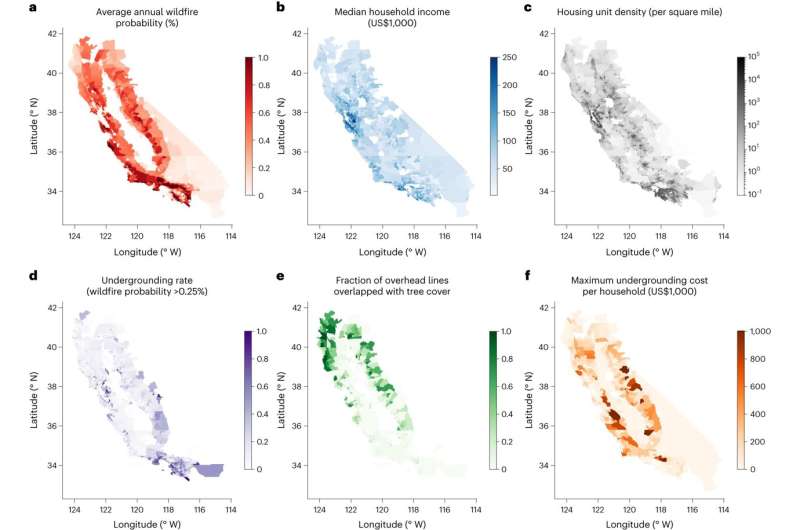This article has been reviewed according to Science X's editorial process and policies. Editors have highlighted the following attributes while ensuring the content's credibility:
fact-checked
peer-reviewed publication
trusted source
proofread
Low-income communities in California have more fire-prone overhead power lines and flammable wooden poles

A tree killed in a climate-driven drought snaps and severs a power line. A transformer sparks. A downed live wire ignites a pile of dry leaves. Many of the country's most damaging wildfires, including California's deadly 2018 Camp and Woolsey Fires, Oregon's 2020 Santiam Fire, and Colorado's 2021 Marshall Fire, can be traced back to failure in the electric grid.
Experts say one of the most permanent and effective approaches to hardening the electrical system to prevent wildfires is burying power lines underground. But costs are steep and the solution is most often implemented in wealthier communities. A new Stanford University study finds lower-income communities in California today have a disproportionate share of fire-prone overhead lines and flammable wooden utility poles, and proposes a way to equitably allocate the cost of moving more lines underground.
The results, published in Nature Energy, come amid increasing threats from climate-fueled wildfires, rapid population growth and development in some of the most fire-prone regions of the American West, and a push from California lawmakers to expedite plans to underground electrical lines.
One key challenge is improving safety without making energy unaffordable for low-income Californians. "There is no way we can underground everything. This new research can inform where efforts and funding are focused," said study co-author Michael Wara, director of the Climate and Energy Policy Program and a senior research scholar at Stanford Woods Institute for the Environment.
The study provides a first-of-its-kind map showing the wildfire vulnerability of power lines across California. The researchers developed an AI model to identify overhead power lines in Google Street View images and fill in gaps where images were unavailable. They then overlaid the results with maps of tree canopies and census data including household income and education levels.
"Overall, we found distribution grids in low-income communities are in a wildfire safety deficit," said lead study author Zhecheng Wang, a postdoctoral scholar in the lab of Ram Rajagopal, an associate professor of civil and environmental engineering at Stanford who co-authored the study.
In addition to the direct threats posed by wildfires, exposed power lines in fire-prone areas can threaten energy security by triggering preemptive power shut-offs during severe weather. Wang and colleagues found these power shut-offs have a bigger impact in low-income neighborhoods, where residents are less likely to have solar panels or generators to keep the lights on and phones charged to receive evacuation orders.
"Our current electric infrastructure leaves low-income communities doubly vulnerable," Rajagopal said. "They're more likely to have power lines at risk during wildfires, and they're less likely to have backup power."
Disproportionate costs
Since the 1960s, California's Public Utilities Commission has allowed local communities, developers, and property owners to identify areas for undergrounding and have a small portion of the costs covered by their utility.
Historically, wildfire threat and income level have not factored into the regulator's criteria for which projects should go ahead or who should pay for them. Instead, these decisions have mostly centered on whether above-ground power lines are an eyesore and whether the local community can afford the project costs, which can run as high as $5 million per mile. As a result, most undergrounding has occurred in affluent communities.
Under the conventional approach, the new analysis reveals the per-household cost of undergrounding existing fire-prone overhead lines in the coming years would be dramatically higher in lower-income census blocks. For blocks in areas where wildfires are most likely to cross paths with power lines, the authors estimate the cost would be $37,000 per household at the $200,000 income level, and more than three times that amount at the $50,000 income level.
Policy solution with widespread benefits
"We need to reshape policies to explicitly take the wildfire risk and income levels as eligibility criteria to socialize the cost," said Wang, who worked on the study as a Ph.D. student in civil and environmental engineering, a department of the Stanford Doerr School of Sustainability and Stanford Engineering.
Together with Stanford Doerr School of Sustainability Dean Arun Majumdar, one of the study's senior authors, Wang and colleagues propose a scheme to allocate costs based on neighborhoods' median household income. They suggest the California Public Utilities Commission grant communities with income levels below a certain threshold the option to split the cost of burying power lines among all utility customers.
Above the income threshold, communities would choose between paying for burying power lines locally or adopting other wildfire protection methods such as replacing wooden powerline poles with steel and regularly trimming trees near wires.
According to the researchers, implementing this scheme could help to make electricity infrastructure "affordable, equitable, and reliable amidst climate change," with benefits extending far beyond local areas most at risk of fire. Public safety shut-offs affect electricity customers throughout the grid, they note, and smoke from grid-caused wildfires can waft hazardous air pollution across thousands of miles. As a result, they write, "Improved grid resilience to wildfires in low-income communities and high-fire-threat areas can benefit all communities."
More information: Wang, Z. et al., Local and utility-wide cost allocations for a more equitable wildfire-resilient distribution grid. Nature Energy (2023). DOI: 10.1038/s41560-023-01306-8 www.nature.com/articles/s41560-023-01306-8















